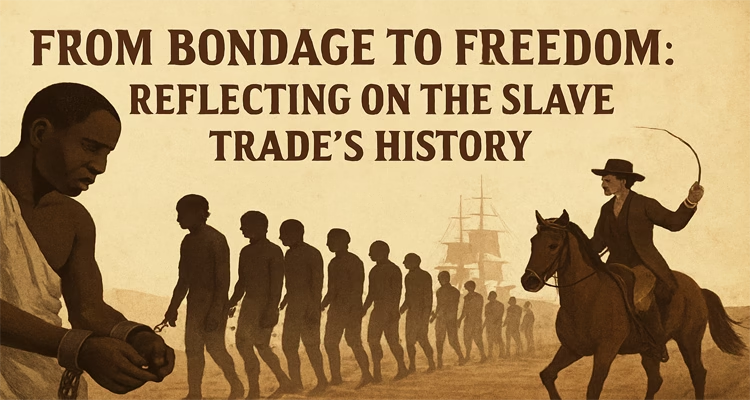
 The International Day for the Remembrance of the Slave Trade and Its Abolition is observed worldwide on 23 August each year. For over four centuries, more than 15 million men, women, and children were forced into the tragic transatlantic slave trade, one of the darkest and most shameful chapters in human history. This international observance is meant not only to remember those who suffered but also to remind the world of the dangers of racism, discrimination, and prejudice that continue even today.
The International Day for the Remembrance of the Slave Trade and Its Abolition is observed worldwide on 23 August each year. For over four centuries, more than 15 million men, women, and children were forced into the tragic transatlantic slave trade, one of the darkest and most shameful chapters in human history. This international observance is meant not only to remember those who suffered but also to remind the world of the dangers of racism, discrimination, and prejudice that continue even today.
Slavery and Its Legacy
The abolition of slavery throughout history has been celebrated as a step toward ensuring equality and human dignity. Yet, oppression and exploitation persist in different forms. In India, marginalized communities such as Dalits, landless laborers, and poor farmers have faced generations of discrimination. Among them, bonded laborers lived in the harshest conditions—treated almost as slaves or serfs for their entire lives.
Records from the 15th century reveal that the slave trade operated with formal “sale agreements”, and it was not uncommon for impoverished parents from lower castes to pledge their children into bonded labor for years. The practice was fueled by deeply entrenched racial and caste hierarchies. The so-called “white race” considered itself superior to black people—whom they derogatorily referred to as Negros—and denied them basic humanity.
Slavery in India
Although slavery was legally abolished in India with the Indian Slavery Act of 1843, it continued in practice until the early 20th century. In South India, historical records show slaves being bought for work on agricultural lands and temples.
Even today, modern slavery exists in new forms. According to the Global Slavery Index, nearly 51 out of every 100 people in India are vulnerable to some form of modern slavery—be it bonded labor, forced begging, forced marriage, domestic servitude, or commercial sexual exploitation. Child marriage and forced marriage remain alarmingly high in countries like India, Bangladesh, Pakistan, Nepal, and Indonesia. In India, the shortage of brides caused by skewed sex ratios has further fueled trafficking and forced marriages.
Constitutional Safeguards and Legal Measures
The Supreme Court of India has consistently ruled that bonded labor amounts to forced labor, making it unconstitutional under Article 23 of the Indian Constitution. To enforce this, Parliament enacted the Bonded Labour System (Abolition) Act, 1976, which made bonded labor a punishable offense.
Former Prime Minister Indira Gandhi described bonded labor as a “barbarous system” that had to be eradicated. Acting on this conviction, the Government of India issued the Bonded Labour Abolition Ordinance on 24 October 1975, which was later converted into law. This marked a significant step toward formally abolishing the remnants of slavery in India.
Continuing Challenges
Despite these legal safeguards, bonded labor continues to exist, mainly as a result of debt and entrenched poverty. Entire families are often trapped in cycles of exploitation, facing violence, coercion, and inhumane working conditions. The system has its roots in India’s feudal and hierarchical social structure, where powerful groups exploit the economically and socially weaker sections.
A Call for Change
The persistence of bonded labor and other forms of modern slavery is a stark reminder that laws alone are not enough. As a society, we must change our attitudes toward marginalized communities and work to uphold the value of human dignity, which forms an essential part of the right to life.
On this day of remembrance, let us not only recall the horrors of slavery in history but also renew our commitment to eliminating exploitation in all its forms, ensuring that freedom, equality, and dignity are a reality for all.
(Written by Vinod Chandrashekhar Dixit)



